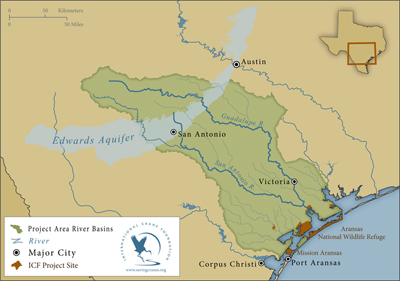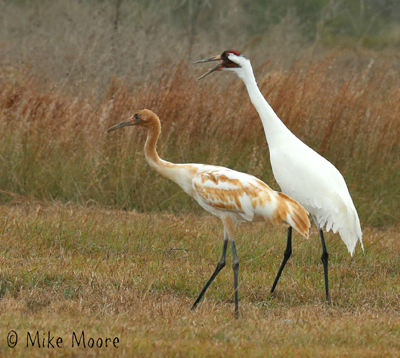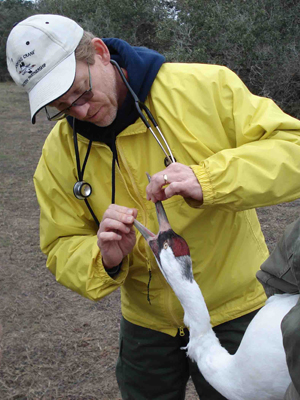By Dr. George Archibald, ICF Co-founder & Senior Conservationist

Late February brought me to Texas to attend three evening functions in Houston and then to participate in the Whooping Crane Festival in Port Aransas, beside the Gulf of Mexico about 200 miles southwest of Houston.
While driving to Port Aransas, I stopped to visit a friend, Laurence Armour, manager of the 35,000 acre Armour family-owned Pierce Ranch, about 9,000 acres of which are under cultivation in approximately equal portions of rice, row crops, and cattle — all managed on a crop rotation schedule. After the rice is harvested, the fields are maintained in shallow water to attract thousands of ducks, geese and Sandhill Cranes, all of which are legally hunted. Although the region was blighted by drought beginning in 2008, in 2013 there were substantial rains after the crops of corn were harvested. The wet soil resulted in germination of waste corn and a crop of mature corn to the benefit of the migratory waterfowl from October through March. This abundance of corn attracted about 50,000 Sandhill Cranes to the Pierce Ranch during the recent winter. In addition, there were many geese, ducks, and untold numbers of shorebirds. The Pierce Ranch demonstrates the symbiosis between wildlife and humans.
This year over 1,500 people attended the Whooping Crane Festival. It began at 6:30 am Friday, February 21, as about 100 visitors gathered at a pavilion beside the docks to have breakfast and hear about cranes from Dr. Sammy King (head of research for the reintroduction of Whooping Cranes in Louisiana), Dr. Elizabeth (Liz) Smith (ICF’s Whooping Crane Conservation Biologist), and yours truly. There we boarded a boat and spent the next five hours on the Intercoastal Waterway, along which small groups of Whooping Cranes searched for food, especially blue crabs, in the wetlands. Around 30-40 cranes are usually spotted, several at close range, during a tour. And while the boat tour was underway, several lectures were being given at the auditorium of the Marine Science Institute of the University of Texas in Port Aransas. Boat tours were repeated Friday afternoon and again on Saturday morning and afternoon, as were the talks. In addition, there were birding tours to a ranch, and many booths with nature-orientated merchandise were set up at the community center in Port Aransas. ICF’s Joan Garland and Betsy Didrickson manned the ICF booth that had a front row location beside the café. Throughout the three days, there were many things to do!
 ICF helped start the first Whooping Crane Festival in Texas in 1996. Ann Vaughan of the Chamber of Commerce in Port Aransas has been the guiding light for most of those years. Dr. Liz Smith is conducting research and working with a diversity of colleagues to help assure that excellent winter habitat will eventually be available for 1,000 Whooping Cranes. Joan Garland spends the winters in Texas conducting programs in schools and sharing crane news on Whooping Crane tour boats, to continue momentum for crane conservation during an upcoming period of history when rising sea levels, the northern spread of black mangroves, and the needs of humans all pose threats to the wintering cranes along the coast of Texas.
ICF helped start the first Whooping Crane Festival in Texas in 1996. Ann Vaughan of the Chamber of Commerce in Port Aransas has been the guiding light for most of those years. Dr. Liz Smith is conducting research and working with a diversity of colleagues to help assure that excellent winter habitat will eventually be available for 1,000 Whooping Cranes. Joan Garland spends the winters in Texas conducting programs in schools and sharing crane news on Whooping Crane tour boats, to continue momentum for crane conservation during an upcoming period of history when rising sea levels, the northern spread of black mangroves, and the needs of humans all pose threats to the wintering cranes along the coast of Texas.
Following the festival, I shared three lovely days at the home of crane conservationists, Al and Diane Johnson. Al is a successful builder and Diane is a homemaker and artist — she creates beautiful jewelry from things she finds in nature. In 1999 they purchased 840 acres of land that borders the Aransas National Wildlife Refuge and St. Charles Bay and where wetlands provide winter habitat for Whooping Cranes. In 2004, the protection of this land was assured through a conservation easement purchased by the Texas Nature Conservancy, but for ten acres where the Johnsons built a guest house and their home. On most days throughout the winter, several Whooping Cranes come to feed on pellets of food scattered automatically by feeders for deer at both homes (above right, photo by Mike Moore). The guest house became the Crane House and is available for rent by the day.
The three days with the Johnsons provided an opportunity to watch wild Whooping Cranes while catching up with a plethora of correspondence that accumulates while I travel. Looking out the side door through an opening between gorgeous and huge live oak trees, one peers into a grassy field with a fresh water pond and a deer feeder. The latter stands about ten feet high on three metal legs that support a container capable of holding about four bushels of pellets or corn. Twice a day the automatic device is activated and about five pounds of contents are scattered around the feeder.

The food is intended for deer. But Whooping Cranes also benefit, especially during winters of drought when there are fewer wolf berries and blue crabs available in the coastal wetlands. One pair of Whooping Cranes came to the feeder at the Crane House for 18 years. They were banded. They produced 14 juveniles, including four sets of two juveniles. Highly territorial, they drove away other Whooping Cranes, although they were more tolerant of deer and Sandhill Cranes. The male stopped coming in his 19th year. The female took a new mate, never brought another juvenile, and disappeared when she was 26 years old. This winter there is a new pair guarding the feeder.
The female carries bands placed on her by the Whooping Crane Tracking Partnership in December 2009. The male is not banded. They do not have a juvenile this winter, but if they follow the example of the former residents, they will have many years of productivity and plenty of food in winter. Actually, the former Crane House pair produced more chicks than other banded pairs of Whooping Cranes.
The Armour family has created on their fields winter habitat for thousands of Sandhill Cranes. Through the Whooping Crane Festival, Ann Vaughan and her colleagues in the Chamber of Commerce of Port Aransas are sharing the cranes’ news each winter with both local people and visitors. The Johnsons are role models for the protection of Whooping Crane habitat. And the hundreds of people that have stayed at the Crane House leave with a natural history memory that will always be with them and that in a myriad of ways will undoubtedly help the cranes.
